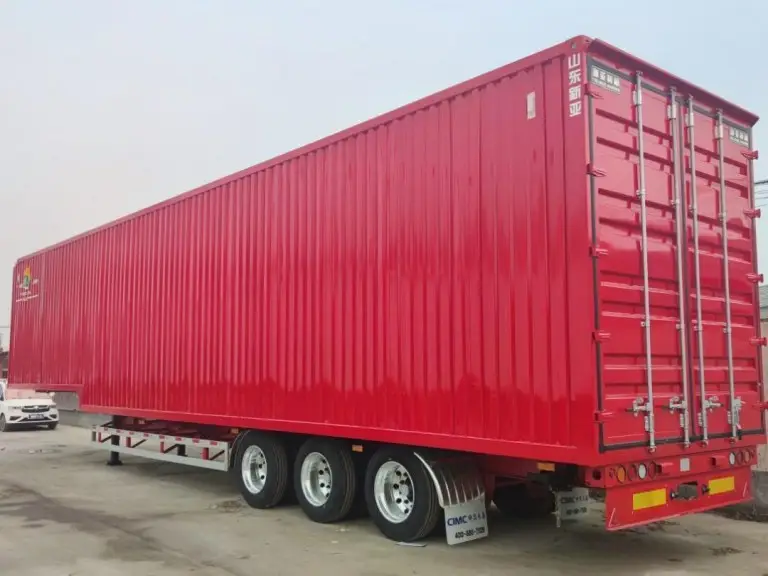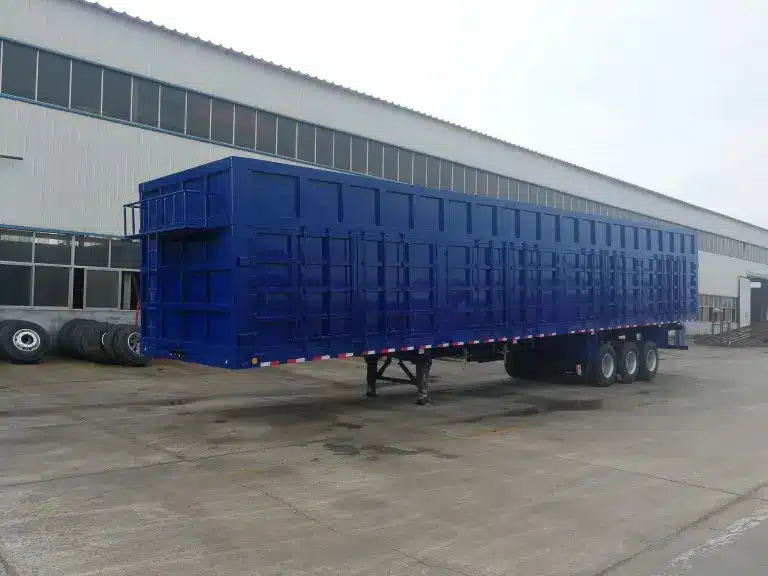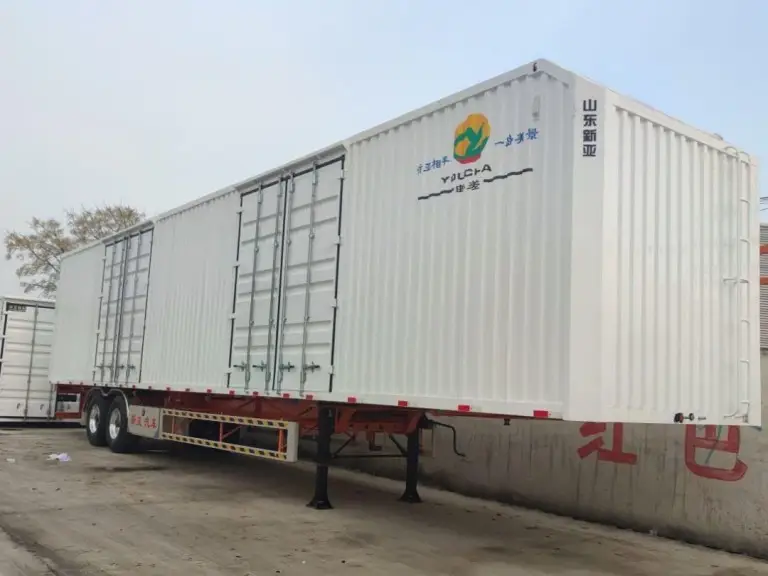Na Genron International Trade, somos frequentemente questionados sobre a conversão de semirreboques em espaços exclusivos. Reboques de baú semi-reboque, com seu amplo espaço e integridade estrutural, são uma ótima base para tais projetos. Oferecem uma base versátil para diversas aplicações.
A ideia de transformar veículos comerciais em espaços habitáveis ou utilizáveis está se tornando cada vez mais popular. As pessoas buscam alternativas econômicas para moradia, negócios móveis e espaços de trabalho especializados. Analisamos as possibilidades e considerações práticas de transformar reboques semi-reboque em áreas funcionais.
Índice
Um reboque semi-caixa pode ser convertido?
Os reboques semi-fechados são versáteis, o que os torna perfeitos para diferentes conversões. Na Genron International Trade, observamos um aumento na reutilização desses reboques para usos inovadores.
Considerações legais para conversões de reboques
Antes de iniciar a conversão de um trailer, é preciso considerar os aspectos legais. As leis sobre conversões de trailers variam, e segui-las é crucial para evitar penalidades. Leis de zoneamento e códigos de construção podem ser aplicáveis, afetando onde e como um trailer pode ser convertido. É importante incluir no orçamento os custos de conformidade, incluindo licenças e inspeções.
Vantagens estruturais de semirreboques para conversão
Semirreboques, especialmente os de baú, apresentam diversas vantagens estruturais para conversão. Sua estrutura robusta proporciona uma base sólida para modificações. O espaço interno é amplo, permitindo designs criativos. A estrutura robusta desses reboques suporta uma ampla gama de usos, desde residências até espaços comerciais.
O interior de um trailer semi-fechado pode ser transformado de diversas maneiras. Adicionar isolamento e controle climático o torna habitável. Instalar prateleiras e estações de trabalho o transforma em uma oficina funcional. As possibilidades são infinitas, limitadas apenas pela criatividade e pelo orçamento do proprietário.
Comece com um semirreboque à medida, concebido para as suas necessidades exactas. Quer se trate de transporte pesado ou de carga especializada, temos a solução perfeita para o manter em movimento.
Aplicações comuns de conversão
Usos comuns para reboques semi-reboque incluem conversões residenciais, comerciais e especializadas. Exemplos incluem:
- Conversões residenciais, como pequenas casas ou espaços de moradia temporários
- Aplicações comerciais, como lojas de varejo móveis ou restaurantes pop-up
- Oficinas especializadas para comerciantes ou artistas
- Aplicações para a indústria de eventos e entretenimento, incluindo palcos móveis ou suítes de hospitalidade
- Usos humanitários e de resposta a desastres, como clínicas médicas móveis ou alojamentos de emergência
O processo de conversão: passo a passo
Transformar um semirreboque em um espaço funcional exige planejamento e execução cuidadosos. O processo envolve várias etapas cruciais para garantir uma transformação bem-sucedida.
Avaliação e Planejamento Inicial
O primeiro passo na conversão de um semirreboque é avaliar suas condições e determinar seu potencial para conversão. Isso envolve avaliar a estrutura do reboque, verificar se há danos ou desgaste e identificar o tipo de modificações que serão necessárias. É essencial considerar o peso e o tipo de equipamento que será instalado, bem como o uso pretendido do reboque convertido.
Durante a fase de planejamento, você precisa considerar vários fatores, incluindo o layout, os requisitos de isolamento e a necessidade de controle climático. Além disso, você precisará avaliar os materiais de isolamento existentes para determinar se eles ainda são eficazes ou se materiais de isolamento adicionais são necessários. Isso é especialmente importante em áreas onde modificações estruturais criaram pontes térmicas.
Modificações Estruturais
Modificações estruturais são uma parte crucial do processo de conversão. Isso pode envolver o corte de seções das paredes ou do piso do trailer para instalar portas, janelas ou outros elementos. Ao fazer essas modificações, é essencial manter a integridade estrutural do trailer, garantindo que ele permaneça seguro e protegido.
O tipo e a extensão das modificações estruturais dependem do uso pretendido do trailer convertido. Por exemplo, converter um semirreboque refrigerado em uma minicasa pode exigir a adição de isolamento no piso e no teto, bem como a instalação de janelas com vidros duplos para melhorar a eficiência térmica. Em alguns casos, é necessário muito planejamento para garantir que a estrutura do trailer suporte o peso de recursos adicionais, como um teto falso para iluminação e isolamento.
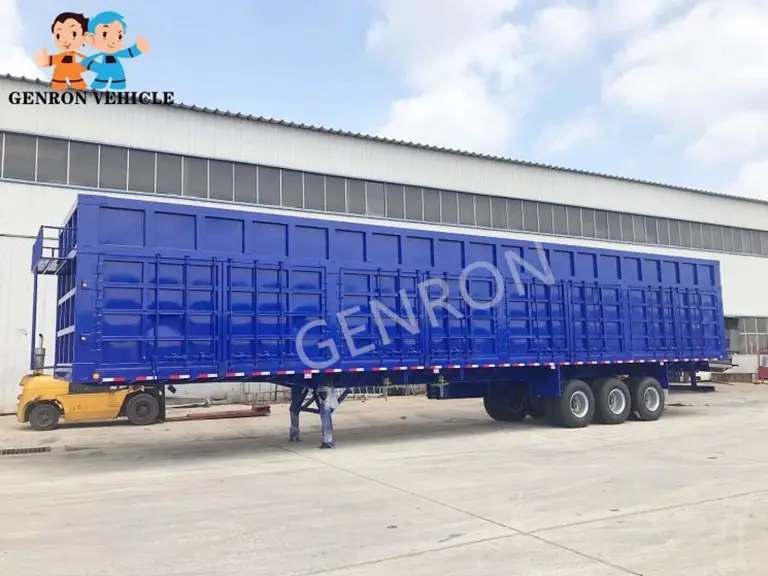
Considerações sobre isolamento e controle climático
Isolamento e controle climático são essenciais na conversão de reboques. Nosso objetivo é criar um espaço interno confortável, independentemente das condições climáticas. Reboques refrigerados costumam ter um bom isolamento. Você pode adicionar mais isolamento no piso e no teto para melhor proteção.
Para controlar o clima, você pode usar sistemas de ventilação passivos e ativos. Gerenciar a umidade também é vital para evitar mofo e danos. A adaptação a diferentes climas pode manter o trailer confortável e funcional. Por exemplo, adicionar isolamento às paredes e pisos ajuda a manter uma temperatura estável. Um sistema de ar bem projetado evita o acúmulo de umidade.
Estratégias de design de interiores para Reboque semi-caixa
Transformar um semirreboque baú em um espaço para morar ou trabalhar é uma arte. Não se trata apenas de torná-lo habitável; trata-se de usar cada centímetro com sabedoria.
- Maximizando o espaço: Os semirreboques baú têm um layout linear, que você pode maximizar. Você pode usar móveis que sirvam para mais de uma finalidade. Por exemplo, um sofá pode ser uma cama ou um depósito.
- Iluminação e Ventilação: Uma boa iluminação e ventilação são essenciais para o conforto. Você pode misturar luz natural e artificial. Claraboias ou janelas grandes trazem luz natural, enquanto fitas de LED ou luminárias fornecem luz artificial.
- Soluções criativas de armazenamento: O armazenamento é um grande desafio na conversão de trailers. Você pode usar o espaço vertical com armários do chão ao teto e armazenamento oculto em escadas ou sob o piso. Isso mantém o espaço organizado e maximiza o armazenamento.
Usando essas estratégias, você pode tornar os semirreboques baú confortáveis, funcionais e eficientes. Eles são adaptados às necessidades específicas do usuário.
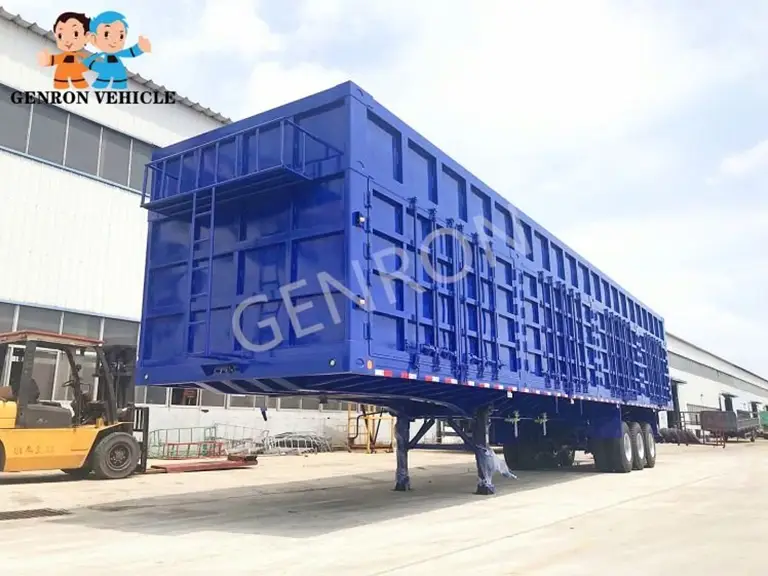
Sistemas elétricos, hidráulicos e mecânicos
Sistemas elétricos, hidráulicos e mecânicos são cruciais na conversão de semirreboques. Eles fornecem a infraestrutura necessária para uma vida ou trabalho moderno.
Opções de energia para reboques convertidos
Existem diversas opções de potência para semirreboques convertidos. A escolha depende do uso do reboque, da disponibilidade de potência e das necessidades energéticas.
- Os sistemas de energia solar são ótimos para uso fora da rede, oferecendo energia sustentável.
- Os geradores são confiáveis, especialmente quando a energia solar não é possível.
- Conectar-se a fontes de energia externas, como a rede elétrica, também é uma opção.
Cada opção de energia tem seus prós e contras. A escolha certa depende de uma avaliação completa das necessidades energéticas.
Gestão de Água e Resíduos
A gestão eficaz de água e resíduos é crucial em um semirreboque convertido, especialmente para uso residencial ou comercial. É necessário projetar um sistema para armazenar, fornecer e descartar água e resíduos de forma eficiente.
Tanques de armazenamento de água são vitais para armazenar água potável. Os sistemas de gerenciamento de resíduos devem lidar com águas cinzas e negras. O tipo de sistema de gerenciamento de resíduos utilizado afeta significativamente a funcionalidade do reboque.
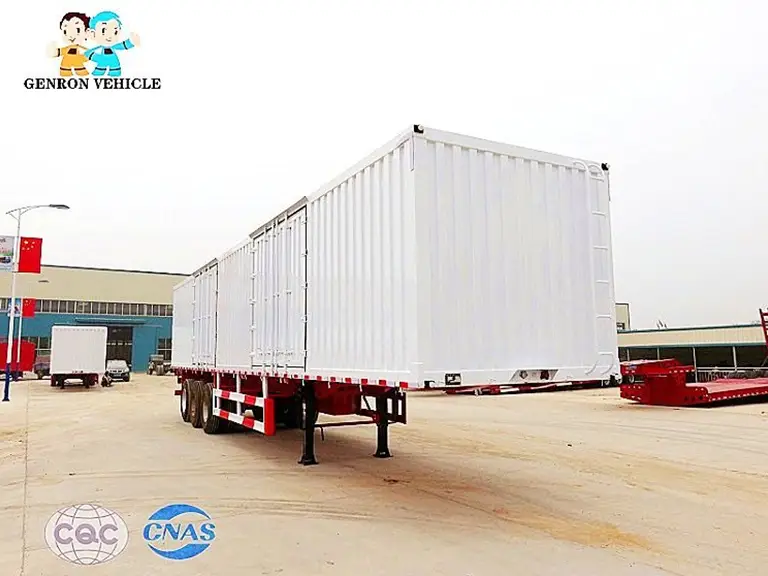
Aquecimento, resfriamento e ventilação
Sistemas de aquecimento, refrigeração e ventilação são essenciais para um clima confortável dentro do trailer. A escolha desses sistemas depende do clima do local onde o trailer será utilizado.
Em áreas como Adelaide, na Austrália, com clima mediterrâneo ou semelhante ao do sul da Califórnia, o controle climático passivo é altamente eficaz. Isso inclui o uso de isolamento em paredes e tetos, massa térmica e ventilação adequada. Essas estratégias podem reduzir ou eliminar a necessidade de sistemas mecânicos.
Para aquecimento, as opções variam de aquecedores de resistência elétrica a bombas de calor mini-split ou sistemas de propano. As soluções de resfriamento devem controlar tanto a temperatura quanto a umidade. Em climas secos, resfriadores evaporativos são eficazes, enquanto em regiões úmidas, o ar-condicionado refrigerado é necessário.
- O isolamento adequado é essencial para manter um clima interno consistente, reduzindo a carga nos sistemas de aquecimento e resfriamento.
- Janelas com vidros duplos podem melhorar significativamente a eficiência térmica.
- Os sistemas de ventilação devem ser projetados para fornecer tanto troca de ar em todo o espaço quanto extração direcionada para áreas como cozinhas e banheiros.
Ao considerar cuidadosamente esses sistemas elétricos, hidráulicos e mecânicos, os indivíduos podem criar uma conversão de semirreboque que não seja apenas funcional, mas também confortável e sustentável ao longo do tempo.
Análise de custos de conversões de semirreboques
Entender os custos envolvidos na conversão de um semirreboque é crucial para o sucesso do projeto. Na Genron International Trade, vimos diversos clientes se beneficiarem da conversão de semirreboques em espaços únicos, seja para moradia, trabalho ou aplicações especializadas.
Custos de Aquisição Inicial
O primeiro passo em um projeto de conversão de semirreboque é adquirir o próprio reboque. O custo de um semirreboque pode variar significativamente dependendo do tamanho, das condições e do uso anterior. Por exemplo, um semirreboque refrigerado de 45 pés pode ser adquirido por aproximadamente US$ $3.000. É significativamente menor do que o custo de um trailer para uma minicasa nos EUA, que pode custar cerca de US$ $8.000.
Recomendamos considerar reboques desativados como uma opção econômica. Esses reboques costumam estar disponíveis a preços mais baixos devido à sua idade ou uso anterior. No entanto, é essencial inspecionar o reboque cuidadosamente para garantir que ele permaneça estruturalmente sólido e adequado para conversão.
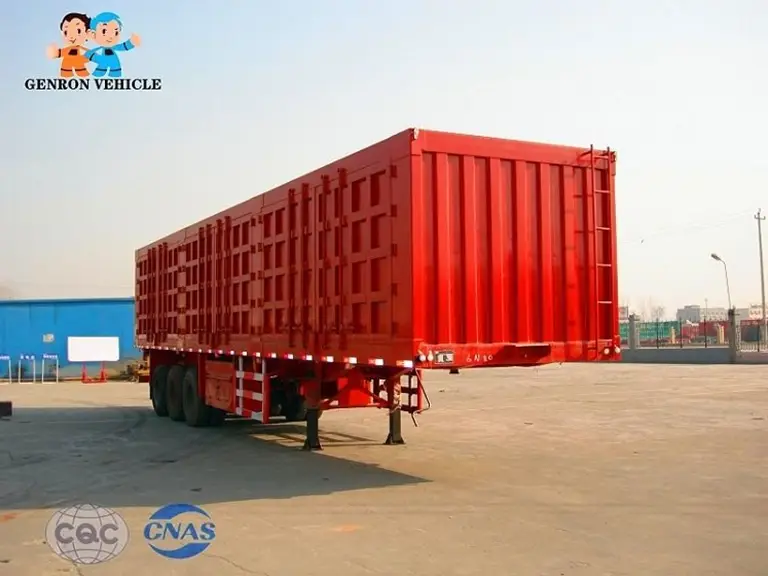
Detalhamento das despesas de conversão
O processo de conversão envolve diversas despesas. Estas incluem modificações estruturais, isolamento, instalações elétricas e hidráulicas e acabamento interno. O custo total pode variar bastante dependendo da complexidade da conversão e dos materiais utilizados.
| Componente de Conversão | Faixa de custo estimado (USD) |
| Modificações Estruturais | $5,000 – $10,000 |
| Isolamento e Controle Climático | $3,000 – $6,000 |
| Instalações Elétricas e Hidráulicas | $4,000 – $8,000 |
| Acabamento Interior | $6,000 – $12,000 |
| Custo Total Estimado | $18,000 – $36,000 |
Considerações sobre o retorno do investimento
As conversões de reboques semi-caixa podem economizar bastante dinheiro em comparação com a construção tradicional de uma casa. Geralmente, custam 40-60% a menos pela mesma metragem quadrada, especialmente em áreas mais caras. Além disso, seu custo de manutenção é menor por serem menores e mais eficientes.
Poder mudar de casa sem vendê-la é uma grande vantagem. Se bem feitas, essas conversões podem até aumentar o valor. Mas, se não forem bem feitas, podem desvalorizar.
Na Genron International Trade, acreditamos que as conversões de semirreboques baú são inteligentes e inovadoras. Com o planejamento adequado, elas podem ser uma ótima opção para muitas necessidades.
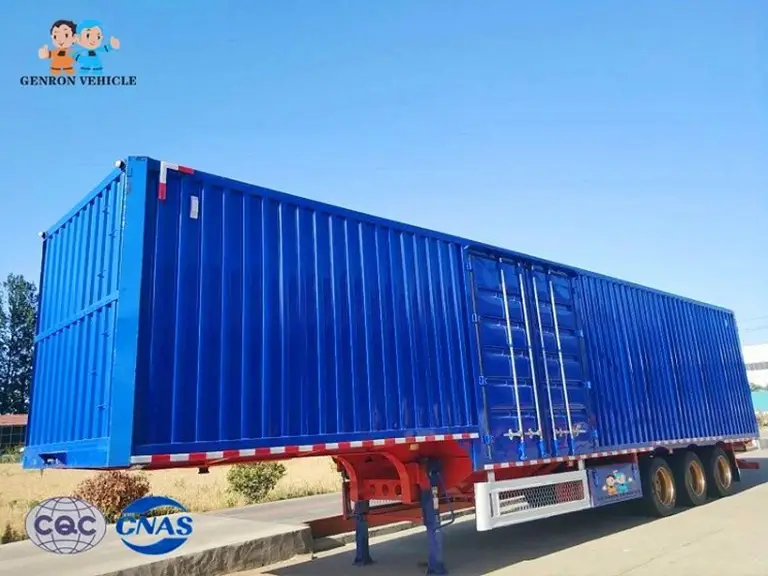
Superando desafios comuns em conversões de reboques
À medida que mais pessoas convertem semirreboques baú, é fundamental conhecer os problemas comuns. Transformar um semirreboque em um espaço habitável exige planejamento cuidadoso e habilidades técnicas. Você também precisa seguir muitas regras.
Problemas de integridade estrutural
Ao converter um semirreboque baú, garantir que ele seja resistente é crucial. Semirreboques são feitos para transportar carga, não para viver. Você precisa verificar a estrutura, o piso e as paredes do reboque. Pode ser necessário adicionar suporte extra ou alterar a estrutura para novos usos.
Por exemplo, se você estiver transformando o local em uma oficina móvel, talvez seja necessário reforçar o piso. Também pode ser necessário modificar as paredes ou o teto para atender às suas necessidades, como adicionar janelas grandes ou portas extras.
Problemas de controle climático e isolamento
Manter a conversão de um trailer confortável significa lidar com o controle climático e o isolamento. Trailers não são projetados para manter a temperatura estável, então você precisará adicionar isolamento. Você também precisará instalar sistemas de aquecimento, ventilação e ar condicionado (HVAC).
O tipo de isolamento que você usa depende do clima e da finalidade do trailer. Em locais frios, você precisará de um bom isolamento térmico para se manter aquecido. Em locais quentes, o isolamento refletivo pode ajudar a manter o ambiente fresco.
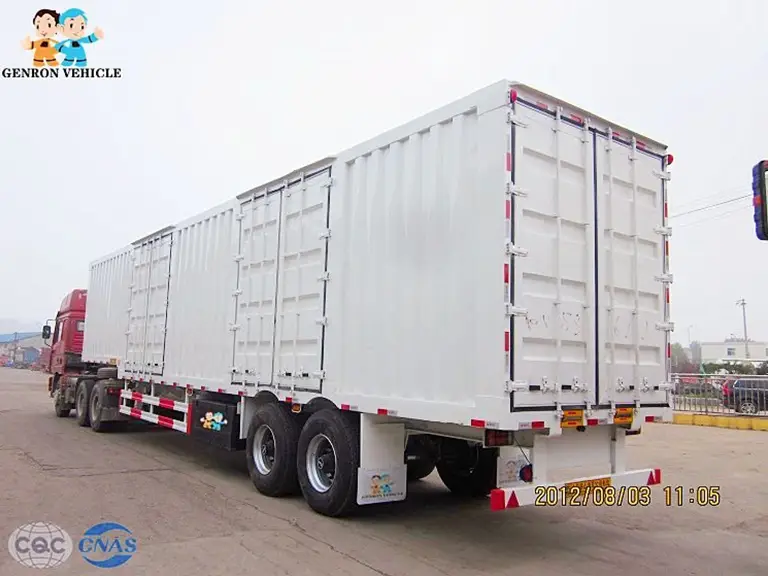
Obstáculos regulatórios e de conformidade
Seguir as regras é um grande desafio. As leis de zoneamento, os códigos de construção e as regras de transporte variam muito. Alguns lugares têm regras rígidas para casas móveis, enquanto outros são mais flexíveis.
- As leis de zoneamento costumam ser o maior obstáculo. Muitos lugares têm regras sobre onde você pode colocar casas móveis.
- Os códigos de construção podem ser diferentes em todos os lugares. Alguns lugares exigem que os trailers atendam aos mesmos padrões que as casas. Outros não.
- As regras de transporte afetam o design e o uso do seu trailer. Os limites de peso, as restrições de tamanho e os equipamentos necessários variam de acordo com o local.
É importante verificar e seguir as leis locais para garantir que a conversão do seu trailer seja legal e segura.
Conclusão
As conversões de semirreboques oferecem infinitas possibilidades além do seu uso original. Elas representam uma alternativa econômica aos métodos tradicionais de construção. Essa abordagem combina inovação com sustentabilidade, demonstrando a versatilidade dos semirreboques.
Considerações técnicas, como integridade estrutural e isolamento, apresentam desafios. No entanto, estes podem ser abordados de forma eficaz com planejamento adequado e expertise. À medida que os cenários regulatórios evoluem, algumas jurisdições estão criando caminhos para a conformidade legal. Seja para uma minicasa pessoal ou uma operação comercial móvel, as conversões de semirreboques oferecem uma combinação atraente de acessibilidade, durabilidade e potencial criativo.
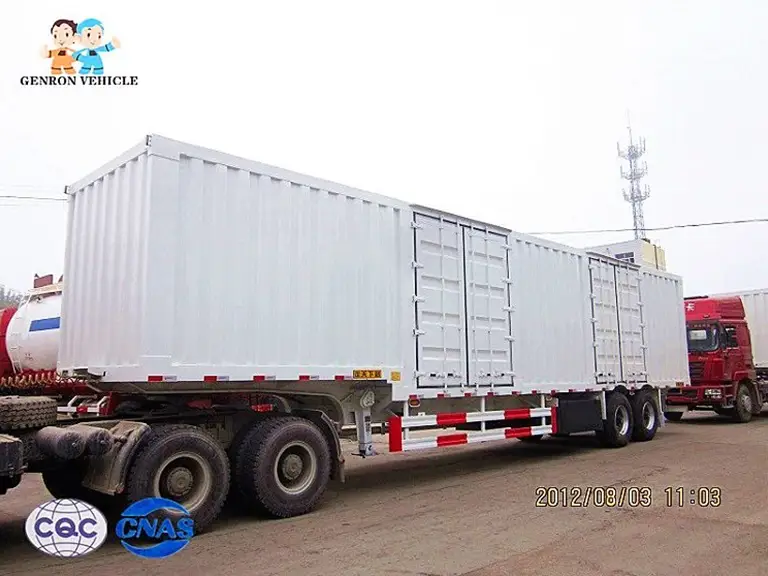
FAQ
Quais são as principais considerações ao converter um semirreboque em um espaço habitável?
Ao converter um semirreboque, você deve se concentrar no isolamento, no controle climático e na integridade estrutural. Isso garante um ambiente confortável e seguro. Planejamento e execução adequados são cruciais para superar desafios comuns.
Como escolher o semirreboque certo para conversão?
Recomendamos avaliar a tamanho do semi-reboque baú, condição e tipo para determinar sua adequação para conversão. Considere fatores como peso, material e uso anterior do trailer para garantir que ele atenda às suas necessidades.
Quais são as aplicações mais comuns para semirreboques convertidos?
Semirreboques convertidos são frequentemente usados como casas móveis, escritórios, oficinas ou espaços comerciais. Sua versatilidade os torna ideais para diversos fins, do residencial ao comercial.


